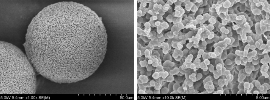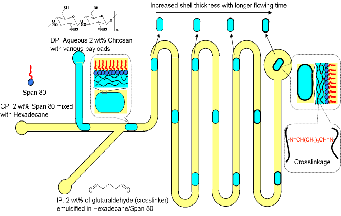![]() Nanotechnologies for Trace Explosives Detection
Nanotechnologies for Trace Explosives Detection
PI: Prof. Don DeVoe
This research thrust has focused on the development of novel nanotechnology-enabled platforms for trace gas-phase explosive detection. Due to the concentration gap between the vapor pressure associated with trace amounts of explosives and the sensitivity limits of established detection modalities, there remains a strong need for new technologies enabling the effective detection of trace explosives. As part of our overall efforts to realize novel materials for label-free and real-time trace explosive detection, we are developing a new porous microparticle technology with the aim of achieving concentration factors of 104-105, at least 2 orders of magnitude higher than established technologies and enabling trace analysis with parts per quadrillion (ppq) detection limits, making the technology suitable for the detection of buried munitions vapor.
Initial project efforts focused on the developing of functionalized nanoporous materials as novel surfaces for ultrasensitive analysis of adsorbed explosives by surface-enhanced Raman spectroscopy (SERS). Three specific material systems were explored in this effort: macroporous polymer monoliths, nanofilament silicon dioxide, and microporous anodic alumina. While initial efforts such as the microporous alumina sensor were successful at demonstrating picomole-level sensitivity for common explosives, including TNT and RDX using SERS readout, the technology required detection from the liquid phase, necessitating cumbersome sample introduction into a solvent before deposition on the alumina surface.

SEM Micrograph of a 70 µm GMA Polymer Monolith Microsphere (left),
and Details of the Porous Structure (right)

Schematic of a Microfluidic Technique for the Synthesis of Monodisperse Particles
We have successfully demonstrated sensitive gas-phase TNT detection, using a single 60 µm diameter nanoparticle-functionalized microbead coupled with a simple optical detector. A bead was placed in a vial with approximately 0.5 g of TNT allowing the bead to adsorb TNT from the equilibrium vapor pressure within the vial before measuring the Raman shift. The resulting measurement revealed a distinct and repeatable band at 1359 cm-1 with a signal-to-noise ratio above 200. Performance of the sensor beads is attributed to enhanced mass loading resulting from the highly porous structures, with the multiscale flow paths between and within the beads ensuring rapid diffusion of explosive vapor into the structures for efficient sample concentration. Testing under controlled conditions to determine ultimate detection limits and adsorption times are ongoing, together with the characterization of other explosive compounds.

